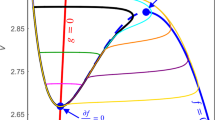Abstract.
Swimming in vertebrates such as eel and lamprey involves the coordination of alternating left and right activity in each segment. Forward swimming is achieved by a lag between the onset of activity in consecutive segments rostrocaudally along the spinal cord. The intersegmental phase lag is approximately 1% of the cycle duration per segment and is independent of the swimming frequency. Since the lamprey has approximately 100 spinal segments, at any given time one wave of activity is propagated along the body. Most previous simulations of intersegmental coordination in the lamprey have treated the cord as a chain of coupled oscillators or well-defined segments. Here a network model without segmental boundaries is described which can produce coordinated activity with a phase lag. This ‘continuous’ pattern-generating network is composed of a column of 420 excitatory interneurons (E1 to E420) and 300 inhibitory interneurons (C1 to C300) on each half of the simulated spinal cord. The interneurons are distributed evenly along the simulated spinal cord, and their connectivity is chosen to reflect the behavior of the intact animal and what is known about the length and strength of the synaptic connections. For example, E100 connects to all interneurons between E51 and E149, but at varying synaptic strengths, while E101 connects to all interneurons between E52 and E150. This unsegmented E-C network generates a motor pattern that is sampled by output elements similar to motoneurons (M cells), which are arranged along the cell column so that they receive input from seven E and five C interneurons. The M cells thus represent the summed excitatory and inhibitory input at different points along the simulated spinal cord and can be regarded as representing the ventral root output to the myotomes along the spinal cord. E and C interneurons have five simulated compartments and Hodgkin-Huxley based dynamics. The simulated network produces rhythmic output over a wide range of frequencies (1–11 Hz) with a phase lag constant over most of the length, with the exception of the ‘cut’ ends due to reduced synaptic input. As the inhibitory C interneurons in the simulation have more extensive caudal than rostral projections, the output of the simulation has positive phase lags, as occurs in forward swimming. However, unlike the biological network, phase lags in the simulation increase significantly with burst frequency, from 0.5% to 2.3% over the range of frequencies of the simulation. Local rostral or caudal increases in excitatory drive in the simulated network are sufficient to produce motor patterns with increased or decreased phase lags, respectively.
Similar content being viewed by others
Author information
Authors and Affiliations
Additional information
Received: 15 December 1995 / Accepted in revised form: 17 September 1996
Rights and permissions
About this article
Cite this article
Wadden, T., Hellgren, J., Lansner, A. et al. Intersegmental coordination in the lamprey: simulations using a network model without segmental boundaries . Biol Cybern 76, 1–9 (1997). https://doi.org/10.1007/s004220050316
Issue Date:
DOI: https://doi.org/10.1007/s004220050316




